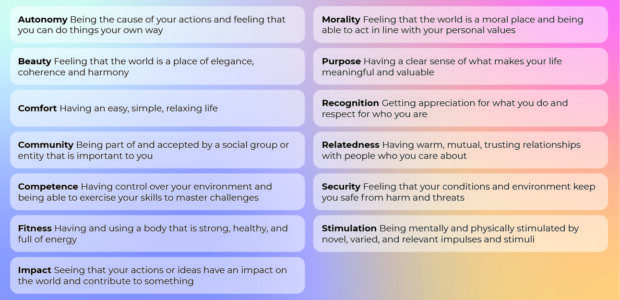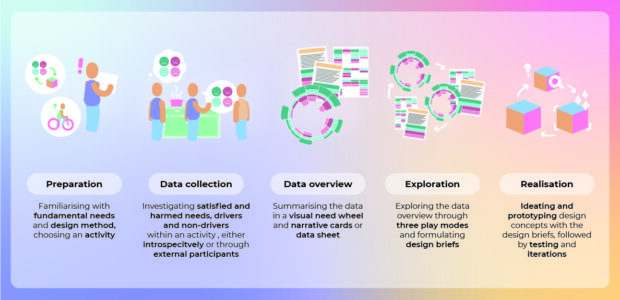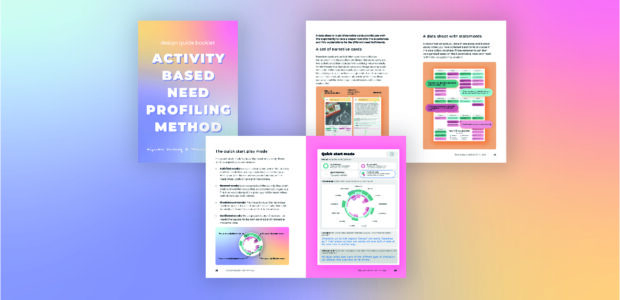By Marinka Roest
Introduction
Going into the kitchen to make yourself a cup of tea or coffee is probably an activity you can relate with. You might even have done it right before you started reading this. Perhaps just because you were thirsty, but if you think a little further, are there any other reasons you might have gotten up to make that cup of tea or coffee? It might be that you felt stuck in the task you were doing and needed a little break or because you enjoy the scent of fresh coffee.
The typology of thirteen fundamental needs (Desmet and Fokkinga, 2020)(figure 1) can help to dive deeper into motivations and behaviours, by looking at it through a different lens. Fundamental needs are needs that everyone has, they are universal and fulfilling them can contribute to people’s feeling of wellbeing. However, everyone is unique and the ways that they fulfil their fundamental needs is different for everyone. For example, with making that cup of tea or coffee, you fulfil your need for competence, because you just learned a new way to make a great cup of coffee. In the meantime, your friend makes their cup of tea, because it gives them a moment to catch up with their family; it fulfils their need for relatedness.

Applying the typology of fundamental needs in a design process could give designers a new perspective on how people interact with the environment around them and a new way of researching people’s behaviours as input for a design concept.
To integrate the typology in a design process, Siyuan Huang and Marinka Roest created an initial version of the activity-based need profiling method. The design method investigates an activity (activity-based) in terms of which fundamental needs it fulfils and in which way (need profiling). An activity is especially interesting, as it includes different users, contexts and products and the connections between these.
In this graduation project, the activity-based need profiling method was expanded by the addition of introspective activities in the data collection phase. Introspection uses one’s own experiences to gather data, which yields detailed and nuanced data, leading to more authentic concepts and a process that supports creativity. In the graduation project, the integration of introspective activities was first evaluated by an individual, personal case study to develop the method expansion. This expansion was evaluated in a second case study with other designers, to assess the usability and value of the newly expanded method.
The result of both the previous research project and this graduation project is this current version of the activity-based need profiling method. The method consists of five phases, and each phase contains several design activities. The design journey ranges from familiarising with the typology of fundamental needs to translating the collected data into a design brief and resulting design concept. One of the underlying values of the design method is flexibility. Designers are free to follow the complete process that the method describes, and get to know different aspects of design, such as the fundamental needs and introspection. However, in some cases, some parts of the process are not as valuable to a specific design project or sometimes parts would work better if they are adjusted a little. Designers who are using the method are free to do so and are encouraged to make the method their own.
The five phases of the activity-based need profiling method are described below and are visualised in figure 2.
- The realisation phase, where designers create design concepts based on the design briefs, validate them and iterate on them.
- The preparation phase, where designers familiarise themselves with the design method and identify an activity to investigate.
- The data collection phase, where designers collect information on need fulfilment within the activity, either introspectively or through external participants. They investigate which needs are satisfied and which are harmed and why this is the case.
- The data overview phase, where designers create both a visual overview as well as a more detailed overview of the collected data.
- The exploration phase, where designers use three strategies, or play modes, to translate the data into design briefs.

The design method is supported by a guide booklet (figure 3), that describes each phase of the process, and a template folder, which contains the materials that support the design method.

More information
The graduation report, the guide booklet and the poster showcase can be found on the TU Delft Repository via this link: http://resolver.tudelft.nl/uuid:d41c50fc-b0e2-41b1-8f4d-d2fbbc9afcb6
The guide booklet and the template folder with the method materials can be downloaded here.
References Desmet, P., & Fokkinga, S. (2020). Beyond Maslow’s pyramid: Introducing a typology of thirteen fundamental needs for human-centered design. Multimodal technologies and interaction, 4(3), 38.



